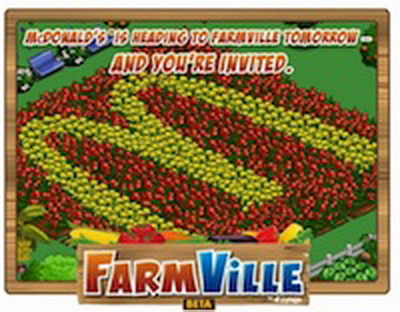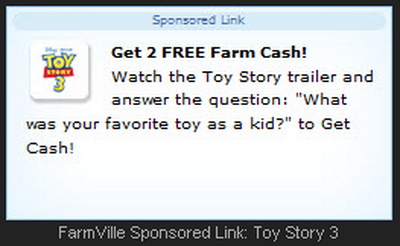解析社交游戏日渐成熟品牌整合机制之初级整合模式
社交游戏的品牌植入方式形态各异,既有贴牌道具,也有将品牌嵌入整个游戏之中。本周我们将通过解析初级品牌整合模式继续探索3大层次的品牌植入。
初级品牌整合通常是在某段有限时间内出售或者展示贴牌商品(游戏邦注:可口可乐能量补充饮料或者福特普锐斯汽车装饰品)。初级品牌整合通常被视为简单的“广告游戏”,即在模拟游戏体验中突出某个品牌,就像数字广告公司SocialVibe携手Zynga推出的Super Bowl浏览器广告,其这是起亚汽车广告活动的组成部分。超越此层次(如能够与玩家互动的电影角色,通过完成超越双击互动任务而获得的贴牌商品)的任何整合活动,称为中级整合甚至是高级整合。
社交游戏的初级整合是从付费植入广告墙(玩家可以通过观看视频、完成调查以及预订服务获取游戏货币)演变而来。为了提升用户价值,游戏开始不再局限于通过提供虚拟货币回馈玩家,有时还给予具有特定游戏功能的贴牌道具。例如, AVG Technologies最近在Zynga《FarmVille》开展了宣传活动,玩家只要在2月24日和3月2日期间购买AVG PC Tuneup就可免费获得1个Biplane道具和3瓶Instant Grow能量剂。Biplane纯粹是个装饰道具,Instant Grow对玩家来说更用性更大,这使得品牌整合对玩家来说更具价值。
初级品牌整合的成本和收益
初级整合活动对于既有社交游戏来说,成本相对较低且容易实施。游戏品牌整合服务公司appssavvy首席执行官Chris Cunningham表示,策划和实施品牌植入方案的典型销售周期为3-6个月。Zynga(游戏邦注:其曾携手appssavvy分别在《FarmVille》和《Cafe World》中为麦当劳和可口可乐公司开展品牌植入活动) 可以选择多种品牌植入方案,这使得活动进展更为迅速,如选择植入视频广告或者用户调查,或者将二者囊括在内。
Zynga品牌广告全球主管Manny Anekal表示,Zynga 6星期就能激活某个品牌。
Anekal表示,“准确来说,在传统的掌机领域,开发商无法在6星期之内就将品牌植入游戏之中,所以我认为这就是Zynga的优势所在。”他描述了公司和电影工作室之间的成功合作关系,他们希望同Zynga开展短期宣传活动,推广即将上映的电影或DVD影片。Anekal表示,“总体来说,电影工作室会自己进行策划,所以我们很幸运,他们策划周期很长,但是如果需要的话,我们短期就能把方案落实到位。”
Anekal接着谈到,电影公司有时仅提供给开发商不到一周时间开展品牌植入活动。为了完成任务,Zynga通常会同SocialVibe合作,在游戏中嵌入视频/调查组合广告,玩家将从中获得虚拟货币回馈。
他表示,“我们最近刚为迪斯尼的《玩具总动员 3》策划了一个品牌整合方案。SocialVibe告诉我们,4段植入视频广告总共只需1分多钟。玩家并非仅仅坐着观看预告片,体验其中品牌植入,而是确确实实融入品牌之中。”
“所以就《玩具总动员 3》而言,其实就是‘玩家观看《玩具总动员 3》预告片,然后告诉我们他们童年最喜欢的玩具’。用户可以在Facebook分享相关信息,所以这其实涵盖了病毒式传播元素。用户于是从中获得某些回馈。‘感谢您观看我们的预告片,谢谢您参与其中,这是我们为您提供的虚拟货币’。这就是我们快速实施整合方案的方式。”
品牌整合成本因品牌和游戏类型的差异也不尽相同。MAU突破百万且DAU不低于50万的大型游戏显然能够为广告商带来更具价值的用户,扩大他们接触新用户的机会,而瞄准细分市场的小型游戏则更多是深化既有用户的品牌联系。初级品牌整合通常采用统一计费方式,广告商无需额外承担制作费用。据悉,小型细分游戏开发商每月能从品牌整合中获利1-2.5万,而中等规模游戏公司每月营收则在2.5-5万美元之间。
除了酬金之外,广告商还得根据玩家的活动参与情况或广告印象支付额外费用(游戏邦注:如开发商和广告商可以共同分成贴牌虚拟商品的销售收入)。
初级整合模式的未来在于加大深度
初级品牌整合很大程度取决于广告商对于游戏玩家的价值认可,但其实开发商才是其中的主宰力量。很多开发商并未为品牌公司开展宣传活动,因为这并不能为游戏玩家带来附加价值,不论广告商给予开发商多么丰厚的酬金。
Anekal表示,“公司的品牌定位需和游戏一致。我们曾拒绝过某些品牌公司,因为植入他们的品牌会贬低我们游戏的价值或者导致用户流失。我们循序渐进,确保广告方案的正确性。”
随着市场的发展,未来初级整合模式有望变身为开发商和品牌公司之间的特定关系,同时某些广告公司将发展成为二者的活动方案经纪人。有关Zynga在初级整合模式中所扮演的角色,Anekal含蓄表示,就是每周开展广告活动,宣传将于每周五上映的新片。此外,Cunningham还谈到了appssavvy即将为广告商推出的平台服务,广告商可以从中购买特定的游戏活动(游戏邦注:如购买商品,参与投票),而非策划整个广告方案。
随着这些合作关系的发展,广告商希望准确获悉玩家行为的价值,而非采用当前的用户参与或广告印象计费方式,因此初级整合的酬金将会直线上升,而开发商则通过采用标准化的整合模式(如《玩具总动员 3》的视频广告),大幅降低活动成本。(本文为游戏邦/gamerboom.com编译,转载请注明来源:游戏邦)
The Maturing Market For Brand Integration With Social Games: Light Integration
Brand engagement through social games covers a wide range of efforts from labeled in-game items to entire games built around a recognizable name. This week, we continue our exploration of the three levels of brand engagement with social games by examining light integration.
Light integration can most easily be characterized by branded items available for sale or display within a game for a limited amount of time, like Coca Cola branded energy boost or a Ford Prius car decoration. Light integration can also be characterized by simple “adver-games” where a brand features a playable simulation on its own site or Facebook page, something like the Super Bowl browser ad powered by digital advertising company SocialVibe in conjunction with Zynga as part of a Kia Motors campaign. Anything beyond this level of integration, say, a character from a motion picture with whom players can interact or branded items only available through a playable quest longer than a two-click interaction, we will confine to medium integration and beyond, which we’ll examine in future articles.
In social games, light integration evolved out of offer walls where players could watch a video, complete a survey, or sign up for a service in exchange for in-game currency. To add value to users, games began rewarding players with more than just virtual currency for their participation, sometimes giving them branded items in-game that served a specific gameplay function. For example, AVG Technologies recently ran a campaign with Zynga’s FarmVille where players could earn a free Biplane item and three Instant Grow boosts in-game by purchasing AVG’s PC Tuneup between February 24 and March 2. The Biplane is purely a cosmetic item while the Instant Grows actually provide utility to the player, making the brand integration more valuable to them.
Costs and Benefits of Light Integration
Light integration campaigns are comparatively cheap and easy to execute for established social games. Chris Cunningham, CEO of brand-to-game integration service appssavvy, says that the typical sales cycle for planning and executing a campaign is between three and six months. In the case of Zynga, which worked with appssavvy on brand campaigns for McDonald’s and Coca Cola in FarmVille and Cafe World respectively, there are several options that allow the developer to activate a brand campaign even more quickly, like integrating video ads, user surveys — or both.
The result, Zynga Global Director of Brand Advertising Manny Anekal tells us, is that his company really only needs six weeks to activate on a brand.
“To put that into perspective, in the traditional console space, you really couldn’t integrate into a console game in six weeks or less, so I think that’s an advantage Zynga has,” Anekal says. He describes the successful relationship the developer enjoys with movie studios who like partner with Zynga for short-term campaigns to promote upcoming film or DVD releases. “In general, movie studios plan in advance so we’re lucky they have very long [lead] times in their planning schedule, but we can execute in the near term if needed.”
Anekal goes on to describe how a movie may sometimes want to increase light integration within in a game with less than a week’s notice. To pull that off, Zynga partners with SocialVibe to deliver combined video/survey ads in-game that rewards users with virtual currency.
“We recently did a program for Disney’s Toy Story 3,” he says. “What SocialVibe has told us is that for our video engagement ads, you’re seeing time spent north of a minute long. People are not only sitting there watching [the] trailer and getting exposed to that, they’re actually engaging with the brand.
“So for Toy Story 3 it was actually ‘Watch the Toy Story 3 trailer, then tell us about your favorite childhood toy.’ You can then share that into your Facebook feed, so there’s a viral element to that. And then, the user gets something. ‘Thank you for watching our trailer, thank you for participating with us, here’s some virtual currency.’ That’s a way in which we can execute very quickly.”
As for costs, it varies both by brand type and by game. Larger games with monthly active users in the millions and daily active users north of 500,000 offer advertisers a more valuable audience with the potential to reach new customers, while smaller games with a niche audience are more about deepening the brand connection with existing customers. Light integration is usually paid for via flat rate fee to cover production costs. We’ve heard that small niche games can fetch between $10,000 and $25,000 per month for brand integration, and mid-sized games range between $25,000 and $50,000 per month.
Beyond the fee, payment comes from cost per engagement or impressions from social game players. In cases where a branded virtual good is for sale, the developer and advertiser share revenues from the sale.
The Future of Light Integration Is Depth of Engagement
Light brand integration depends heavily on how much an advertiser feels a game’s audience is worth, but the real power in the dynamic comes from developers. Most game developers will not do campaigns with brands that don’t offer some added value to players, no matter how much money the advertiser offers the developer.
“The brand target needs to match the target of the game,” Anekal says. “We have said no to brands where it would detract from the gameplay or take away from the audience. We’re taking baby steps to make sure our advertising is done right.”
As the market evolves, we expect to see light integration formalize into specified relationships between games and brands and also to see a set of advertising companies try to position themselves as campaign brokers between the two. For Zynga’s part on light integration, Anekal hints at a more regular set of weekly campaigns to promote upcoming Friday releases of films. Cunningham, meanwhile, describes appssavvy’s upcoming platform service for advertisers that would allow them to purchase a specific in-game activity (e.g. buying a good, completing a poll, etc.) as opposed to planning out an entire campaign.
As these relationships develop, we expect to see the price of light integration shift upward as advertisers try to work out how much a user’s action is worth compared to the current value of cost per engagement or impressions measurements, while the overall cost to developers shifts downward through standardized integration mechanics like the Toy Story 3 video ad. Join us next week for a look at medium level brand integration with social games. To find out more about specific branded campaigns within social games, sign up for The Facebook Marketing Bible.(Source:Inside Social Games)










































 闽公网安备35020302001549号
闽公网安备35020302001549号